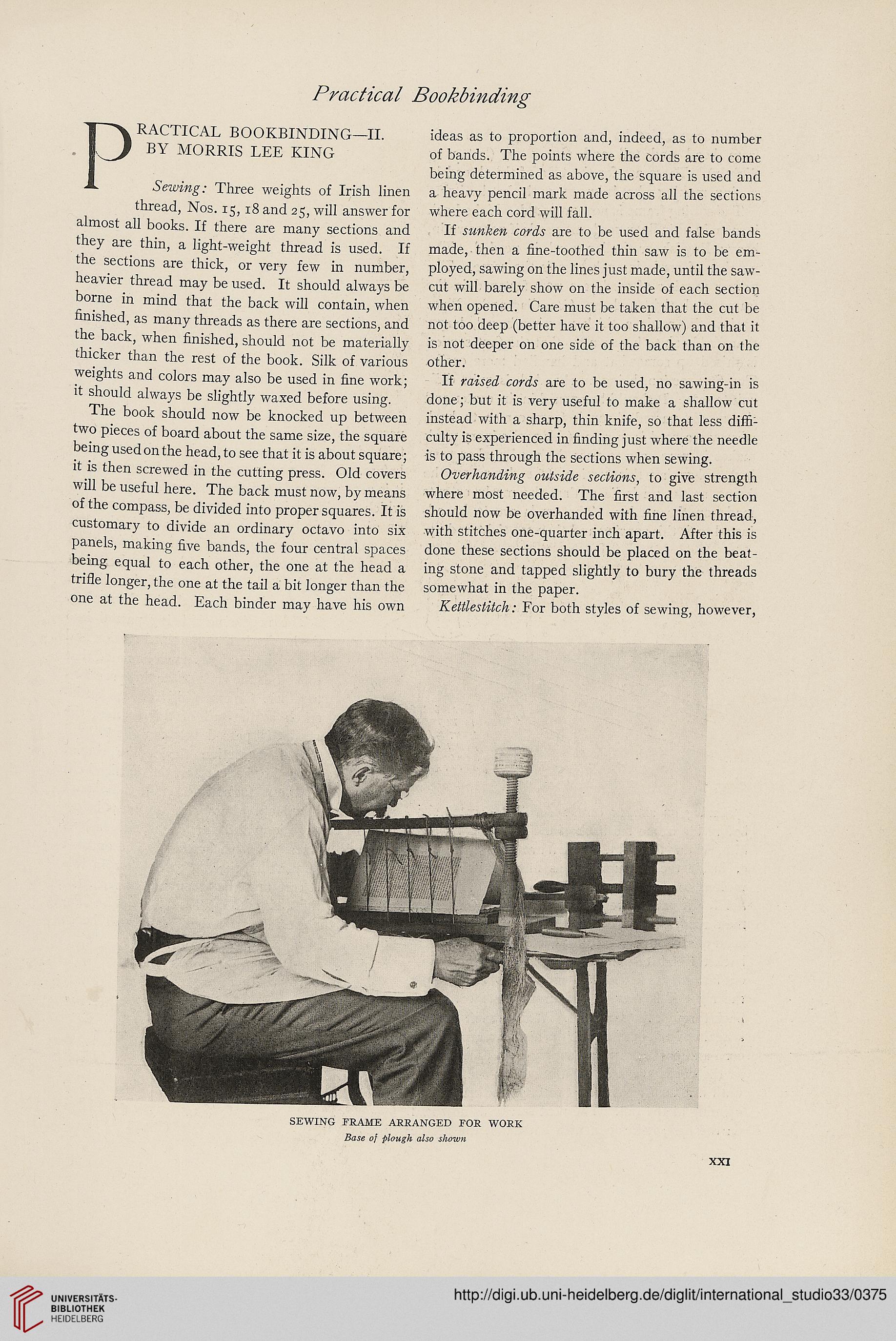Practical Bookbinding
P
RACTICAL BOOKBINDING—II.
BY MORRIS LEE KING
Sewing: Three weights of Irish linen
thread, Nos. 15,18 and 25, will answer for
almost all books. If there are many sections and
they are thin, a light-weight thread is used. If
the sections are thick, or very few in number,
heavier thread may be used. It should always be
borne in mind that the back will contain, when
finished, as many threads as there are sections, and
the back, when finished, should not be materially
thicker than the rest of the book. Silk of various
weights and colors may also be used in fine work;
it should always be slightly waxed before using.
The book should now be knocked up between
two pieces of board about the same size, the square
being used on the head, to see that it is about square;
it is then screwed in the cutting press. Old covers
will be useful here. The back must now, by means
of the compass, be divided into proper squares. It is
customary to divide an ordinary octavo into six
panels, making five bands, the four central spaces
being equal to each other, the one at the head a
trifle longer, the one at the tail a bit longer than the
one at the head. Each binder may have his own
ideas as to proportion and, indeed, as to number
of bands. The points where the Cords are to come
being determined as above, the square is used and
a heavy pencil mark made across all the sections
where each cord will fall.
If sunken cords are to be used and false bands
made, then a fine-toothed thin saw is to be em-
ployed, sawing on the lines just made, until the saw-
cut will barely show on the inside of each section
when opened. Care must be taken that the cut be
not too deep (better have it too shallow) and that it
is not deeper on one side of the back than on the
other.
If raised cords are to be used, no sawing-in is
done; but it is very useful to make a shallow cut
instead with a sharp, thin knife, so that less diffi-
culty is experienced in finding just where the needle
is to pass through the sections when sewing.
Overhanding outside sections, to give strength
where most needed. The first and last section
should now be overhanded with fine linen thread,
with stitches one-quarter inch apart. After this is
done these sections should be placed on the beat-
ing stone and tapped slightly to bury the threads
somewhat in the paper.
Kettlestitch: For both styles of sewing, however,
SEWING FRAME ARRANGED FOR WORK
Base of plough also shown
XXI
P
RACTICAL BOOKBINDING—II.
BY MORRIS LEE KING
Sewing: Three weights of Irish linen
thread, Nos. 15,18 and 25, will answer for
almost all books. If there are many sections and
they are thin, a light-weight thread is used. If
the sections are thick, or very few in number,
heavier thread may be used. It should always be
borne in mind that the back will contain, when
finished, as many threads as there are sections, and
the back, when finished, should not be materially
thicker than the rest of the book. Silk of various
weights and colors may also be used in fine work;
it should always be slightly waxed before using.
The book should now be knocked up between
two pieces of board about the same size, the square
being used on the head, to see that it is about square;
it is then screwed in the cutting press. Old covers
will be useful here. The back must now, by means
of the compass, be divided into proper squares. It is
customary to divide an ordinary octavo into six
panels, making five bands, the four central spaces
being equal to each other, the one at the head a
trifle longer, the one at the tail a bit longer than the
one at the head. Each binder may have his own
ideas as to proportion and, indeed, as to number
of bands. The points where the Cords are to come
being determined as above, the square is used and
a heavy pencil mark made across all the sections
where each cord will fall.
If sunken cords are to be used and false bands
made, then a fine-toothed thin saw is to be em-
ployed, sawing on the lines just made, until the saw-
cut will barely show on the inside of each section
when opened. Care must be taken that the cut be
not too deep (better have it too shallow) and that it
is not deeper on one side of the back than on the
other.
If raised cords are to be used, no sawing-in is
done; but it is very useful to make a shallow cut
instead with a sharp, thin knife, so that less diffi-
culty is experienced in finding just where the needle
is to pass through the sections when sewing.
Overhanding outside sections, to give strength
where most needed. The first and last section
should now be overhanded with fine linen thread,
with stitches one-quarter inch apart. After this is
done these sections should be placed on the beat-
ing stone and tapped slightly to bury the threads
somewhat in the paper.
Kettlestitch: For both styles of sewing, however,
SEWING FRAME ARRANGED FOR WORK
Base of plough also shown
XXI




